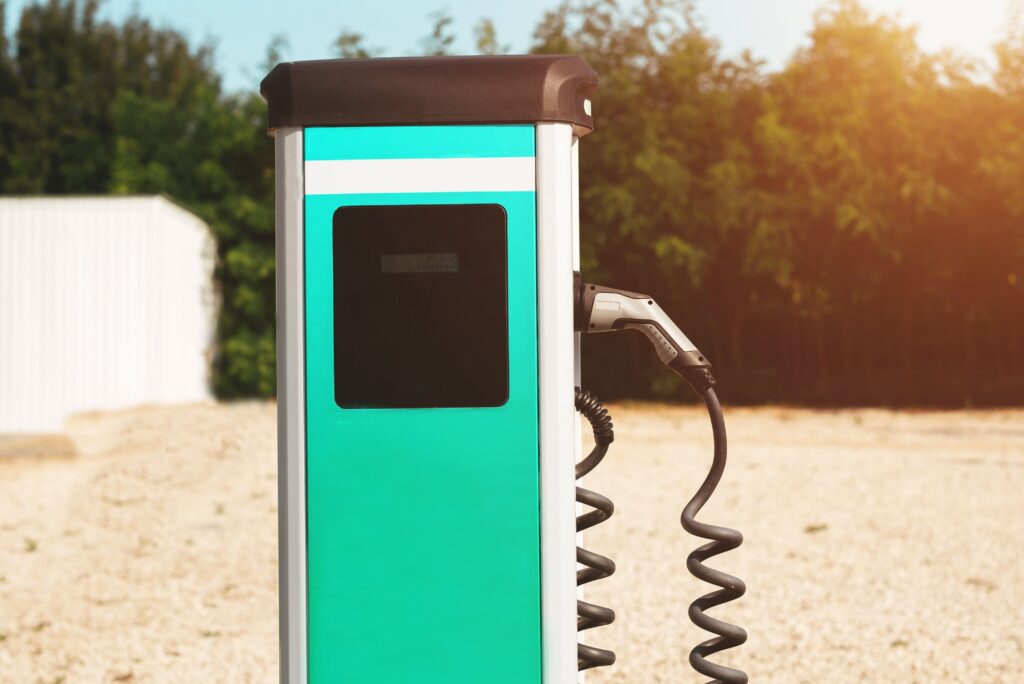Rapid DC chargers give electric vehicles a significant boost in a short amount of time, making them a practical choice for busy commercial sites. A Rapid DC charger delivers direct current straight to the vehicle’s battery, allowing you to add substantial range in as little as 15 to 30 minutes. This speed can keep fleets moving, reduce downtime, and improve the experience for anyone relying on quick turnarounds. ElecrAssure installs DC chargers across the UK as well as other commercial ev chargers.
You can find these chargers in places like service stations, retail car parks, and fleet depots where time is critical. Commercial EV chargers are now being installed across the UK, making rapid charging solutions widely accessible for businesses and drivers nationwide. Unlike slower AC chargers, Rapid DC units bypass the car’s onboard charger, which is why they can deliver such high power output. Choosing the right model means looking at factors such as power rating, connector type, and the electrical capacity of your site.
With the growing number of electric vehicles on the road, installing a commercial Rapid DC charger can attract customers, support sustainability goals, and future-proof your operations. As technology advances, faster charging speeds and better energy integration will make them even more valuable for business use.
Key Takeaways
- Rapid DC chargers supply high power directly to EV batteries for faster charging
- The right charger choice depends on power output, connectors, and site capacity
- Growing EV adoption makes Rapid DC chargers a strong investment for businesses
Understanding Rapid DC Chargers
Rapid DC chargers deliver high power directly to your electric vehicle’s battery, allowing you to add significant range in a short time. They use direct current instead of alternating current, which removes the need for the car’s onboard charger to convert the electricity. This makes them much faster than standard home or public AC charging points. As commercial EV charging points, rapid DC chargers play a crucial role in the broader network of electric vehicle charging points, supporting scalable infrastructure for businesses and public spaces.
What Is a Rapid DC Charger?
A rapid DC charger, often called a DC fast charger or Level 3 charger, is designed for speed. These chargers typically provide between 50kW and 350kW of power, though 100kW and 150kW units are becoming more common in the UK. Some rapid DC chargers are available as a single unit, delivering between 50kW and 250kW, offering a simple, integrated solution for commercial sites.
You will usually find them at motorway service stations, petrol forecourts, and commercial hubs. They are intended for quick top-ups during journeys rather than overnight charging.
Unlike slower AC charge points, rapid DC chargers can add 60–200 miles of range in 20–40 minutes, depending on the charger’s output and your vehicle’s battery capacity. However, charging speed can slow down as the battery approaches full to protect battery health.
Direct Current vs Alternating Current Charging
Electricity from the grid is supplied as alternating current (AC). Most home and workplace chargers use AC, which your vehicle converts into direct current (DC) to store in the battery.
This conversion is done by the car’s onboard charger, which limits the maximum AC charging speed. For example, if your car’s onboard charger is rated at 7kW, it cannot charge faster than that on AC, even if the charge point can supply more power.
Rapid DC chargers bypass this step. They convert AC to DC inside the charging unit itself, then send DC power straight to the battery. The AC to DC conversion inside the charger is a crucial stage in the charging process, representing one of the key sequential steps required to deliver power efficiently to the battery. This allows much higher charging rates, making them ideal for short stops on long trips.
Types of Rapid DC Chargers for Commercial Use
Rapid DC chargers, also called Level 3 chargers, vary in design and configuration to suit different commercial needs. Key differences affect charging capacity, flexibility, and how many vehicles you can serve at once. Choosing the right setup can impact installation costs, uptime, and customer experience.
Reviewing case studies of successful commercial rapid DC charger installations can provide valuable insights into selecting the best charger type for your business. These real-world examples highlight how different solutions meet specific industry needs.
Fixed vs Modular Systems
A fixed DC fast charger has a set power output that cannot be expanded. For example, a 50 kW unit will always deliver that capacity. This option can be cost-effective if your site has stable demand and limited space.
A modular DC charger uses power modules that can be added or removed. You might start with 100 kW and later expand to 200 kW without replacing the entire unit. This can reduce long-term costs if you expect demand to grow.
Key differences:
| Feature | Fixed System | Modular System |
|---|---|---|
| Power upgrade | Not possible | Scalable by adding modules |
| Initial cost | Lower | Higher |
| Flexibility | Low | High |
| Maintenance | Simple | May require specialist work |
If your site serves a growing EV fleet, modular systems can help you adapt without major downtime. However, they require more complex installation and may need stronger electrical infrastructure.
Single and Dual Port Designs
A single-port DC charger can charge one vehicle at a time. This may be suitable for low-traffic areas or fleet depots where charging schedules are predictable.
A dual-port DC fast charger can serve two vehicles at once. Some models split power between ports, while others provide full power to each port if only one is in use.
Advantages of dual-port chargers:
- Serve more drivers without adding extra units
- Reduce queuing in busy locations
- Increase potential revenue for public charging sites
However, dual-port level 3 chargers may require higher grid capacity and cost more to install. If your location experiences high turnover, the ability to charge two EVs simultaneously can improve site efficiency and customer satisfaction.
Installation and Infrastructure Considerations
Installing rapid DC chargers requires careful planning to ensure they operate efficiently, meet demand, and comply with regulations. You need to assess your site, confirm electrical capacity, follow correct installation procedures, and maintain the equipment to keep it reliable and safe for users.
When reviewing local planning rules and zoning requirements, note that in most cases, planning permission is required if significant structural changes are needed for installing electric vehicle charging points.
Site Assessment and Grid Capacity
You should start with a detailed site survey to identify the best location for your EV charging stations. Look at parking space availability, accessibility for different vehicle sizes, and proximity to your main electrical supply.
Rapid DC chargers draw high power, so you must check your grid connection capacity. A qualified electrician can determine if your site needs an upgrade to handle the additional load.
Consider future demand. If EV use in your area is growing, plan for extra chargers or higher capacity from the start. This helps avoid costly upgrades later.
You should also review local planning rules and zoning requirements. Some councils may have restrictions on placement or require specific design features for public chargers.
Installation Process and Safety
Work with an installer experienced in commercial EV charging. They should handle everything from equipment selection to commissioning. Many businesses choose partners who can also manage permits and compliance.
The installation process often includes:
- Preparing foundations or mounting points
- Installing electrical cabling and switchgear
- Connecting to the grid
- Testing and commissioning the chargers
Safety is critical. All work must follow UK wiring regulations (BS 7671) and relevant safety standards. This includes proper earthing, surge protection, and clear signage for users.
If your chargers are in public areas, ensure they meet accessibility requirements, such as those outlined in the Equality Act 2010.
Maintenance and Support
Rapid DC chargers require regular checks to remain reliable. You should set up a planned maintenance schedule that includes cleaning, inspecting cables, and testing output performance.
Many businesses use remote monitoring software to track charger status. This allows you to detect faults early and reduce downtime. Some systems also provide usage reports to help you measure return on investment.
Choose an installation partner that offers ongoing support and quick response times for repairs. Keeping spare parts on hand can also help you restore service faster when issues occur.
How Rapid DC Chargers Work
When you plug into a DC fast charger, the unit communicates with your vehicle to agree on the maximum safe charging rate. This depends on your battery’s design, temperature, and state of charge.
The charger then delivers high-voltage DC electricity directly to the battery. Common connector types include CCS (Combined Charging System) and CHAdeMO, though CCS is becoming the standard in Europe. Rapid DC chargers are compatible with a wide range of plug-in vehicles, ensuring broad usability across different makes and models.
Charging starts quickly at high power, then tapers off as the battery fills to avoid overheating or overcharging. This is why it’s most efficient to charge from around 20% to 80% rather than to full.
For fleet operators, rapid DC chargers can reduce downtime and improve utilisation. This makes them valuable in commercial EV operations where time is critical.
Key Features of Commercial Rapid DC Chargers
Commercial rapid DC chargers deliver high charging speeds, support multiple connector types, and often include integrated payment systems. As a solution tailored for businesses, these chargers are designed to address the unique needs of organizations seeking efficient and reliable EV charging infrastructure. They are designed to reduce vehicle downtime, handle frequent use, and meet the needs of both public and private EV charging stations.
Speed and Power Output
Rapid DC chargers supply direct current at high power levels, typically between 50kW and 350kW. This allows most electric vehicles to reach about 80% charge in under an hour.
A 50kW unit is suitable for locations with moderate traffic, such as small retail car parks. Higher-powered chargers, like 150kW or 350kW models, are better for motorway service areas where quick turnaround is essential.
The charging speed depends on both the charger’s output and the EV’s battery capacity (What Affects EV charging Speed – Best Chargers). Some vehicles can only accept lower rates, so installing ultra-high-power chargers may not always increase charge times for all users.
Connector Types and Compatibility
Most commercial rapid DC chargers offer multiple connector options to serve different EV models. Common standards include:
| Connector Type | Typical Use Case | Max Power Range |
|---|---|---|
| CCS (Combined Charging System) | Widely used in Europe | Up to 350kW |
| CHAdeMO connector | Popular with some Japanese EVs | Up to 100kW |
| Type 2 (AC) | Backup or slower charging | Up to 22kW AC |
A dual-connector charger can serve both CCS and CHAdeMO connectors, improving accessibility. These chargers offer charging options for multiple vehicle types, enhancing flexibility for commercial sites. Before installation, you should assess your expected user base to ensure the right mix of connectors for your EV charging stations.
User Experience and Payment Options
Modern commercial rapid DC chargers often feature touchscreen displays, clear charging instructions, and real-time session data. This helps drivers quickly start a session without confusion. Drivers can initiate a charging session with a simple tap of a contactless card or mobile app, making the process convenient and fast.
Payment systems vary. Many chargers support contactless bank card payments, RFID cards, or mobile app integration. Users can pay for charging sessions using various methods, including pay-as-you-go and contactless options. Some also allow pre-paid accounts for fleet operators.
Paying for rapid charging is straightforward, with clear instructions and flexible payment options available to suit different user preferences.
You can choose chargers with OCPP (Open Charge Point Protocol) support, which lets you connect to various back-office systems. This flexibility can help you manage pricing, monitor usage, and provide remote support without being locked into one provider.
Accessible design, reliable uptime, and straightforward payment processes can make your charging location more attractive to EV drivers.
Benefits of Rapid DC Chargers for Businesses
Rapid DC chargers deliver high power directly to electric vehicle batteries, enabling much faster charging than standard AC units. These chargers can be configured to meet diverse business requirements, including flexible pricing and usage monitoring. For businesses, this can mean higher customer turnover, better utilisation of EV charging stations, and improved operational efficiency for fleets.
Reduced Charging Times
Rapid DC chargers can add significant range in a short period — often 100–200 miles in under 30 minutes, depending on the vehicle and charger capacity.
By converting AC power to DC within the charging unit, these stations bypass the vehicle’s onboard converter. This allows you to deliver energy at a much higher rate, reducing wait times for drivers.
Faster charging is especially valuable for sites with high traffic, such as motorway service areas, retail parks, and urban hubs. Shorter sessions mean more vehicles can use the same charger in a day, increasing throughput.
For example, DC rapid charging can serve multiple EVs in the time it would take an AC fast charger to handle one or two, making the investment more viable in busy locations.
Attracting Customers and Increasing Revenue
Offering rapid charging can make your location a preferred stop for EV drivers. Many will choose a site where they can recharge quickly while shopping, eating, or using other services.
This can lead to increased footfall and longer dwell times in your business, especially if your site offers amenities that drivers can use while waiting.
You can set competitive charging tariffs or offer loyalty discounts, creating an additional revenue stream. By providing reliable and convenient charging, businesses can build a loyal customer base among EV drivers who are more likely to return regularly. Networked charging solutions also allow you to monitor usage and adjust pricing based on demand.
Businesses that install visible, well-placed rapid chargers can also enhance their brand image as forward-thinking and environmentally responsible, appealing to both EV owners and sustainability-conscious customers.
Supporting Fleet Operations
For fleets — whether delivery vans, taxis, or service vehicles — downtime is costly. Rapid DC chargers help keep your vehicles on the road by reducing the time spent at EV charging stations.
This is particularly important for high-mileage fleets that cannot rely solely on overnight AC charging. With rapid charging, you can top up vehicles during short breaks or between jobs without disrupting schedules.
Fleet managers can also use networked chargers to track energy usage, schedule charging to avoid peak electricity rates, and ensure vehicles are ready when needed.
Installing rapid chargers at depots or key route points can improve operational efficiency, reduce the need for spare vehicles, and support the transition to electric vehicles without compromising service levels.
Future Trends in Rapid DC Charging
Rapid DC charging is moving towards higher power levels, better efficiency, and closer integration with energy management systems. These changes aim to reduce charging times, improve network reliability, and make it easier for you to operate or use electric vehicle charging infrastructure.
Ultra-Rapid Charging Developments
Ultra-rapid DC chargers now reach 350 kW or more, allowing many electric vehicles to gain up to 200 miles of range in under 20 minutes. This is especially useful for high-mileage fleets and motorway charging hubs.
You will see more chargers using liquid-cooled cables to handle higher currents safely. This helps maintain performance without overheating the equipment.
Manufacturers are also improving compatibility with different EV battery chemistries. Some next-generation chargers will adjust power delivery based on the vehicle’s thermal limits to protect battery health.
In busy locations, multi-port DC systems will allow several vehicles to charge at full speed at the same time. This reduces wait times and increases site throughput.
| Feature | Benefit |
|---|---|
| 350 kW+ output | Much shorter charging sessions |
| Liquid cooling | Safe, reliable high-current delivery |
| Smart power allocation | Optimised charging for multiple EVs at once |
Integration with Smart Technologies
Rapid DC chargers are increasingly linked to smart grid and energy management platforms. This allows you to schedule charging during off-peak hours, reducing electricity costs.
Some systems connect with renewable sources such as solar or wind. This can lower the carbon footprint of your charging operations and improve sustainability.
You can also expect more chargers to support vehicle-to-grid (V2G) or vehicle-to-building (V2B) functions. These let EVs send stored energy back to the grid or a facility, providing backup power or grid balancing.
Remote monitoring and diagnostics will become standard. This enables faster fault detection and reduces downtime without the need for on-site checks.


